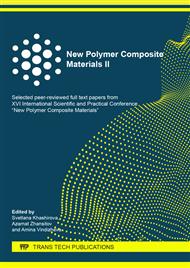[1]
I.Yu. Averko-Antonovich, Synthetic Latexes, Alpha-M, Moscow, (2005).
Google Scholar
[2]
S. Byeongho, K. Jonghyub, J. Sukhee, K. Yonggu, K. Wonho, Characteristics of Styrene-Butadiene Rubber/Silica/Nanoprene Compounds for Application in Tire Tread, Journal of Nanoscience and Nanotechnology. 13 (2013) 2179-2188.
DOI: 10.1166/jnn.2013.7088
Google Scholar
[3]
S.V. Bagryashov, S.I. Vol'fson, S.V. Turenko, Y.M. Kazakov, The dynamic properties of vulcanisates using nanoprene® rubbers, International Polymer Science and Technology. 39 (2012) 41.
DOI: 10.1177/0307174x1203900511
Google Scholar
[4]
S.V. Bagryashov, Y.M. Kazakov, S.V. Turenko, S.I. Vol'fson, Nanoprene® – additive enhancing the compatibility of precipitated silica fillers with general rubbers, Kauchuk i rezina. 5 (2011) 10-14.
Google Scholar
[5]
B.S. Grishin, Theory and practice of reinforcing elastomeric composites. Status and direction of development, KNRTU publishing house, Kazan, (2016).
Google Scholar
[6]
V. Mittal, Miniemulsion Polymerization Technology, Scrivener Publishing LLC., Salem, (2010).
Google Scholar
[7]
M.A. Ibragimov, Possibilities of miniemulsion polymerization for creation of latex and polymers. Overview, Bulletin of the Kazan Technological University. 15 (2012) 119-126.
Google Scholar
[8]
D. Crespy, K. Landfester, Miniemulsion polymerization as a versatile tool for the synthesis of functionalized polymers, Beilstein J. Org. Chem. 6 (2010) 1132-1148.
DOI: 10.3762/bjoc.6.130
Google Scholar
[9]
P.J. Blythe, B.R. Morrison, K Mathauer. E.D. Sudol, M.S. El-Aasser, Polymerization of miniemulsions containing predissolved polystyrene and using hexadecane as costabiliser, Langmuir. 16 (2000) 898-904.
DOI: 10.1021/la990126d
Google Scholar
[10]
N.V. Galkina, A.P. Rakhmatullina, M.A. Ibragimov, Z.A. Saitbattalova, B.S. Grishin, A.G. Liakumovich, Industrial production and use elastomers. 4 (2015) 23-27.
Google Scholar
[11]
M.A. Ibragimov, Z.A. Saitbattalova, N.V. Galkina, A.P. Rakhmatullina, I.Sh Nasyrov, Synthesis and study of the properties of functionalized polymer fillers, Bulletin of the Technological University. 19 (2016) 45-48.
Google Scholar
[12]
M.A. Ibragimov, A.A. Akmyradow, A.P. Rakhmatullina, Modification of emulsion styrene-butadiene rubber with mineral and polymer fillers, Bulletin of the Technological University. 22 (2019) 65-69.
Google Scholar


